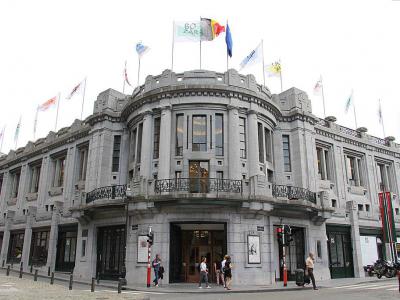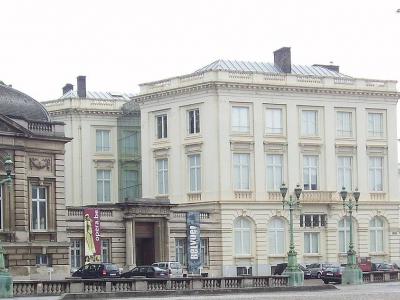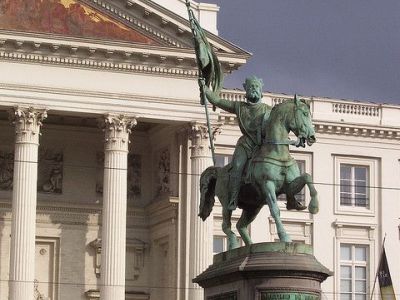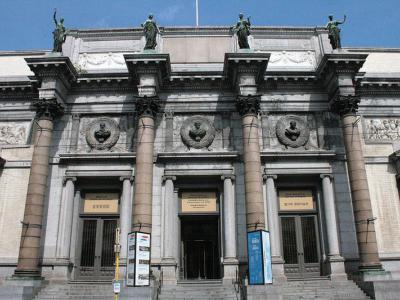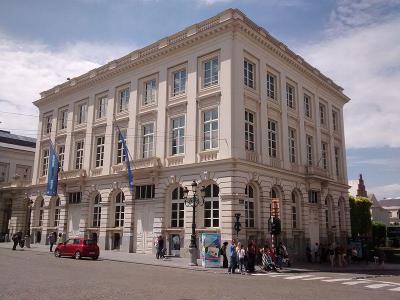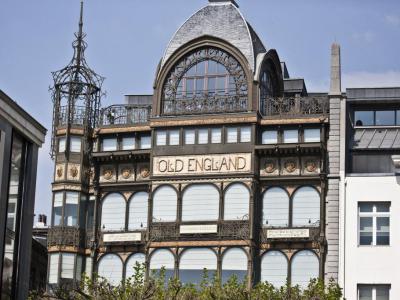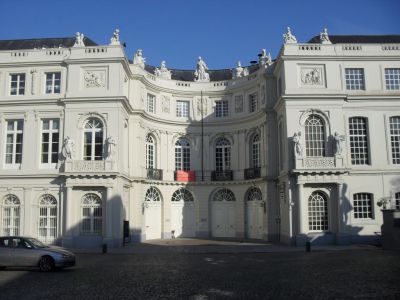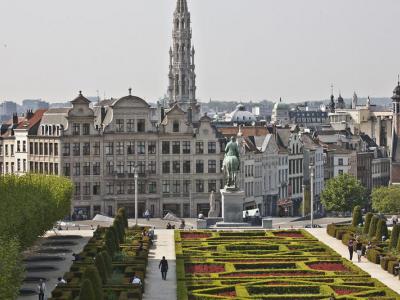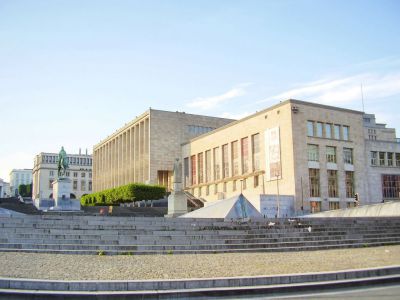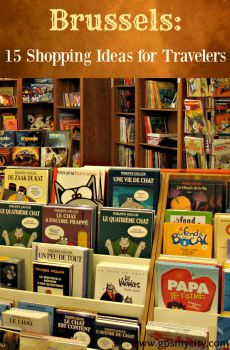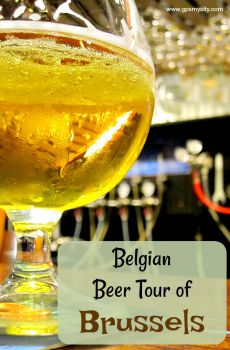Mont Des Arts Cultural Walk (Self Guided), Brussels
Mont des Arts, meaning "hill of the arts", is one of the most important cultural sites in Brussels. A classic among the city’s vantage points, it offers a fine city garden and restored showcase of architecture, in addition to several great museums.
Start your journey by traveling towards the old part of the city, where you’ll find the BOZAR Centre for Fine Arts, greatly admired for its interior detail. Major cultural events are held there; temporary exhibitions take place in the foyer, so something is always happening. By contrast, the nearby BELvue Museum’s interiors are modern, with nice exhibits that show the history of Brussels mostly from 1800 until present day.
Further along the way, you’ll see the bell tower of a grand neoclassical church, Saint-Jacques-sur-Coudenberg. This part of the city was significantly changed by Charles of Lorraine, governor of the Low Countries in the mid-18th century, who looked towards Vienna for inspiration to create a unified architectural ensemble.
Later, in 1880, King Leopold II, wishing to make the upper part of the city an artistic hub, commissioned the Palace for the Arts – now the Royal Museums of Fine Arts – to house various collections. An easy choice for an afternoon in Brussels, the combination of The Old Masters Museum, Modern Museum, and Magritte Museum is a veritable steal for the cost of admission and a required stop for anyone who loves painting and European art in particular.
Join us on this self-guided walking tour to better make your way through these and many other highlights Mont des Arts has to offer.
Start your journey by traveling towards the old part of the city, where you’ll find the BOZAR Centre for Fine Arts, greatly admired for its interior detail. Major cultural events are held there; temporary exhibitions take place in the foyer, so something is always happening. By contrast, the nearby BELvue Museum’s interiors are modern, with nice exhibits that show the history of Brussels mostly from 1800 until present day.
Further along the way, you’ll see the bell tower of a grand neoclassical church, Saint-Jacques-sur-Coudenberg. This part of the city was significantly changed by Charles of Lorraine, governor of the Low Countries in the mid-18th century, who looked towards Vienna for inspiration to create a unified architectural ensemble.
Later, in 1880, King Leopold II, wishing to make the upper part of the city an artistic hub, commissioned the Palace for the Arts – now the Royal Museums of Fine Arts – to house various collections. An easy choice for an afternoon in Brussels, the combination of The Old Masters Museum, Modern Museum, and Magritte Museum is a veritable steal for the cost of admission and a required stop for anyone who loves painting and European art in particular.
Join us on this self-guided walking tour to better make your way through these and many other highlights Mont des Arts has to offer.
How it works: Download the app "GPSmyCity: Walks in 1K+ Cities" from Apple App Store or Google Play Store to your mobile phone or tablet. The app turns your mobile device into a personal tour guide and its built-in GPS navigation functions guide you from one tour stop to next. The app works offline, so no data plan is needed when traveling abroad.
Mont Des Arts Cultural Walk Map
Guide Name: Mont Des Arts Cultural Walk
Guide Location: Belgium » Brussels (See other walking tours in Brussels)
Guide Type: Self-guided Walking Tour (Sightseeing)
# of Attractions: 13
Tour Duration: 1 Hour(s)
Travel Distance: 1.0 Km or 0.6 Miles
Author: audrey
Sight(s) Featured in This Guide:
Guide Location: Belgium » Brussels (See other walking tours in Brussels)
Guide Type: Self-guided Walking Tour (Sightseeing)
# of Attractions: 13
Tour Duration: 1 Hour(s)
Travel Distance: 1.0 Km or 0.6 Miles
Author: audrey
Sight(s) Featured in This Guide:
- BOZAR Centre for Fine Arts
- BELvue Museum
- Godfrey of Bouillon Statue
- Saint Jacques-sur-Coudenberg
- Royal Museums of Fine Arts
- Musee Magritte (Magritte Museum)
- Musical Instruments Museum (MIM)
- Palace of Charles of Lorraine
- Mont des Arts (Mount of the Arts)
- Royal Library of Belgium
- Musee de l'Imprimerie (Printing Museum)
- Statue of Albert I
- Statue of Queen Elisabeth I
1) BOZAR Centre for Fine Arts
The Centre for Fine Arts is a primary cultural venue in Brussels. Its construction was completed in 1928. Funding was originally denied for the project; however, a society dedicated to construction of a fine arts center was established in 1922. This society renewed interest in building a fine arts center. The government finally supported the construction but put some restrictions on the building. For one, it needed to include shopping on the ground floor. Also, the height of the building was to be limited so as to not block the King’s skyline views from the Royal Palace.
The building features an Art Deco architectural style and was designed by Art Noveau architect Victor Horta. The building is recognized as an Art Deco masterpiece and is often lauded for its ability to put together many uses and functions into a relatively small building plot. The design incorporates eight different building levels, with much of it underground. The complex includes a sizable concert hall, recital room, chamber music room, lecture rooms, and has an extensive gallery for temporary exhibits. Today, the building goes by the name BOZAR and features several different artistic departments.
Why You Should Visit:
Brussel's multicultural hot-spot – be it an exhibit, a concert, a screening or any other cultural activity, this is where they will premiere.
The Henry Le Bœuf Great Hall (2,200 seats) is a must-see in itself – a beautiful oval concert hall with marvelous acoustics.
Not only is the centre well worth seeing but the area is wonderful to roam around, too!
Tip:
If you have little time and/or money, check out which free exhibition(s) they have on display.
The building features an Art Deco architectural style and was designed by Art Noveau architect Victor Horta. The building is recognized as an Art Deco masterpiece and is often lauded for its ability to put together many uses and functions into a relatively small building plot. The design incorporates eight different building levels, with much of it underground. The complex includes a sizable concert hall, recital room, chamber music room, lecture rooms, and has an extensive gallery for temporary exhibits. Today, the building goes by the name BOZAR and features several different artistic departments.
Why You Should Visit:
Brussel's multicultural hot-spot – be it an exhibit, a concert, a screening or any other cultural activity, this is where they will premiere.
The Henry Le Bœuf Great Hall (2,200 seats) is a must-see in itself – a beautiful oval concert hall with marvelous acoustics.
Not only is the centre well worth seeing but the area is wonderful to roam around, too!
Tip:
If you have little time and/or money, check out which free exhibition(s) they have on display.
Sight description based on Wikipedia.
2) BELvue Museum
For those interested in the national history of Belgium, the BELvue Museum is the place to be. The museum is next to the Royal Palace and is located in the 18th century Bellevue Hotel. The hotel served as a resting point for wealthy travelers and dignitaries. In 1977 the hotel was transformed into the present-day museum. Spread over three floors and twelve rooms, the museum exhibits cover the major periods in Belgium’s history from 1830 to 2005, with special emphasis on the Belgian Revolution, World War I and World War II.
Contemporary topics like suffrage, the golden 60s, and state reforms are also presented. The exhibits are rich in original documents and audiovisual testimonials, which provides additional context to the topics on display. Two floors of the museum maintain the original styles of Napoleon III and Louis XV, and are decorated with 18th century furniture. Each of the Belgian kings has an exhibit which takes the visitor through a series of works and portraits which display each king’s unique personality and accomplishments. Temporary rotating exhibits are also presented at the museum.
The BELvue is open from 9:30 am to 5 pm Tuesday until Friday, Monday only for groups with reservation, and from 10 am to 6 pm Saturday and Sunday in July and August.
Contemporary topics like suffrage, the golden 60s, and state reforms are also presented. The exhibits are rich in original documents and audiovisual testimonials, which provides additional context to the topics on display. Two floors of the museum maintain the original styles of Napoleon III and Louis XV, and are decorated with 18th century furniture. Each of the Belgian kings has an exhibit which takes the visitor through a series of works and portraits which display each king’s unique personality and accomplishments. Temporary rotating exhibits are also presented at the museum.
The BELvue is open from 9:30 am to 5 pm Tuesday until Friday, Monday only for groups with reservation, and from 10 am to 6 pm Saturday and Sunday in July and August.
Sight description based on Wikipedia.
3) Godfrey of Bouillon Statue
This imposing statue was erected in the Royal Square in 1843. It depicts Godfrey of Bouillon on a horse and was designed by Eugène Simonis. Known for being one of the leaders of the First Crusade, Bouillon was a Frankish knight born in the Brabant region of France (which is now part of Belgium). The First Crusade was called by Pope Urban II in 1096 and was meant to liberate Jerusalem and aid the Byzantine Empire. Both of these places were under attack from Muslim forces.
Godfrey felt compelled to participate in the Crusade and wanted to pull together a group of knights to fight in the Holy Land. By taking out loans or selling his land outright, he was able to gather thousands of knights. He died in Jerusalem in 1100. There are differing reports of the cause of his death, from getting shot with an arrow, to contracting an illness, to getting poisoned. Godfrey of Bouillon’s legacy continues on through his appearance in classic written texts. For example he was named the hero on Tasso’s Gerusalemme Liberata. In The Divine Comedy the spirit of Godfrey is seen by Dante in the Heavens of Mars. Mark Twain gives a mention of Godfrey’s sword in “Innocents Abroad.”
Godfrey felt compelled to participate in the Crusade and wanted to pull together a group of knights to fight in the Holy Land. By taking out loans or selling his land outright, he was able to gather thousands of knights. He died in Jerusalem in 1100. There are differing reports of the cause of his death, from getting shot with an arrow, to contracting an illness, to getting poisoned. Godfrey of Bouillon’s legacy continues on through his appearance in classic written texts. For example he was named the hero on Tasso’s Gerusalemme Liberata. In The Divine Comedy the spirit of Godfrey is seen by Dante in the Heavens of Mars. Mark Twain gives a mention of Godfrey’s sword in “Innocents Abroad.”
Sight description based on Wikipedia.
4) Saint Jacques-sur-Coudenberg
The Church of Saint James on Coudenberg is a neoclassical Roman Catholic church located on the historic Place Royale/Koningsplein in central Brussels. The medieval abbey church that originally stood on this location was demolished by command of Charles Alexander of Lorraine during his expansive urban planning projects, despite having escaped the great fire of 1731 that destroyed the nearby Coudenberg Palace.
The new church was built in line with Rue Montagne de la Cour/Hofberg on its present location on the Place Royale/Koningsplein. Construction of the facade was started by architect Gilles-Barnabé Guimard after the designs of Jean-Benoît-Vincent Barré (1775). The first stone was solemnly laid by Charles Alexander of Lorraine on 12 February 1776. The portico was finished in 1780. The nave, transept, choir and sacristy were built under supervision of Louis Montoyer in the years 1785–1786.
After the consecration of the building, it was used as an abbey and parish church at the same time. Moreover, it was the official church of the court of the Governors of the Habsburg Netherlands. The present building was designed to serve as the Church of the Abbey of Saint-Jacques on the Coudenberg and therefore has a deep extended choir with place for choir stalls for the monks.
During the French Revolution, the abbey was suspended and the church was made into a Temple of Reason, and then later into a Temple of Law. The church was returned to Catholic control in 1802. On 21 July 1831, Prince Leopold of Saxe-Coburg-Gotha took the oath that made him H.M. Leopold I, the first King of the Belgians, on the front steps of the church.
The new church was built in line with Rue Montagne de la Cour/Hofberg on its present location on the Place Royale/Koningsplein. Construction of the facade was started by architect Gilles-Barnabé Guimard after the designs of Jean-Benoît-Vincent Barré (1775). The first stone was solemnly laid by Charles Alexander of Lorraine on 12 February 1776. The portico was finished in 1780. The nave, transept, choir and sacristy were built under supervision of Louis Montoyer in the years 1785–1786.
After the consecration of the building, it was used as an abbey and parish church at the same time. Moreover, it was the official church of the court of the Governors of the Habsburg Netherlands. The present building was designed to serve as the Church of the Abbey of Saint-Jacques on the Coudenberg and therefore has a deep extended choir with place for choir stalls for the monks.
During the French Revolution, the abbey was suspended and the church was made into a Temple of Reason, and then later into a Temple of Law. The church was returned to Catholic control in 1802. On 21 July 1831, Prince Leopold of Saxe-Coburg-Gotha took the oath that made him H.M. Leopold I, the first King of the Belgians, on the front steps of the church.
Sight description based on Wikipedia.
5) Royal Museums of Fine Arts (must see)
The Royal Museums of Fine Arts are situated in downtown Brussels, on the small hill of Coudenberg (Koudenberg), and comprise four museums under the umbrella of the Royal Museum of Belgium. Two of them, such as the Museum of Ancient Art and the Museum of Modern Art, are in the main building, while the other two – the Museum Constantin Meunier and the Antoine Wiertz Museum – are found in different locations, considerably smaller and dedicated to specific Belgian artists.
The Royal Museum contains over 20,000 drawings, sculptures, and paintings spanning from the early 15th century to the present. The museum has an extensive collection of Flemish paintings, among them the works of Bruegel, Rogier van der Weyden, Robert Campin, Anthony van Dyck, and Jacob Jordaens. A particular pride of the museum is the "Rubens Room" housing more than 20 works of the artist.
Why You Should Visit:
An easy choice for an afternoon in Brussels, the combination of The Old Masters Museum, Modern Museum, and Magritte Museum is a veritable steal for the cost of admission and although at times clustered, the variety and expanse of the collection is something that needs to be seen. Not free, but inexpensive and the extra charge for the audio guide is well worth it. You can buy entry to all the collections or just one.
The Royal Museum contains over 20,000 drawings, sculptures, and paintings spanning from the early 15th century to the present. The museum has an extensive collection of Flemish paintings, among them the works of Bruegel, Rogier van der Weyden, Robert Campin, Anthony van Dyck, and Jacob Jordaens. A particular pride of the museum is the "Rubens Room" housing more than 20 works of the artist.
Why You Should Visit:
An easy choice for an afternoon in Brussels, the combination of The Old Masters Museum, Modern Museum, and Magritte Museum is a veritable steal for the cost of admission and although at times clustered, the variety and expanse of the collection is something that needs to be seen. Not free, but inexpensive and the extra charge for the audio guide is well worth it. You can buy entry to all the collections or just one.
Sight description based on Wikipedia.
6) Musee Magritte (Magritte Museum) (must see)
The captivating Magritte Museum houses an extensive collection of the Surrealist artist's belongings, along with a modest assortment of his early paintings and sketches. Magritte and his wife Georgette resided on the ground floor of this unassuming house from 1930 until the mid-1950s. It's an unconventional location for what effectively served as the headquarters of the Surrealist movement in Belgium, where many of its prominent figures gathered every Saturday to collaborate on a variety of subversive publications and images.
Offering a fascinating glimpse into the life of one of the 20th century's most influential artists, the museum faithfully recreates the ground floor as his studio and living quarters, using original furnishings and decor, with the rest meticulously replicated from photographs. The famous bowler hat, featured in several of Magritte's paintings, hangs near the indoor studio. Many elements of the house itself, such as the sash window, glass doors, fireplace, and staircase, as well as the lamppost out front, prominently appear in the artist's works.
In the garden, Magritte constructed a studio named "Dongo", where he produced his more commercial work, like graphics and posters, although he was often discontented when engaged in such mundane projects. His true artistic passion flourished in the dining-room studio, where he displayed a single work by another artist – a photograph by Man Ray – which remains there today.
Visitors are required to wear shoe-covers when exploring the first and second floors, which were separate apartments during the Magrittes' residency but now house a chronological display of letters, photos, posters, sketches, and other items related to the artist and his time here. There are also personal objects in the attic, which Magritte rented, including the easel he used in his later years.
Why You Should Visit:
Thoughtfully organized over three floors, offering a nice escape into a different world for a few hours.
Interesting to witness the development of Magritte's major themes and his transition into a retired surrealist.
The gift shop features a wide range of art prints on various objects at reasonable prices.
Tips:
Make time for the Magritte film on the same level as the gift shop, and consider getting an audio guide for the best experience, though note that the ordering can be a bit confusing in certain areas. Also consider buying an "all museums" ticket, which is affordable and grants access to two interconnected museums (Oldmasters Museum, Royal Museums of Fine Arts), eliminating the need to exit between visits.
Offering a fascinating glimpse into the life of one of the 20th century's most influential artists, the museum faithfully recreates the ground floor as his studio and living quarters, using original furnishings and decor, with the rest meticulously replicated from photographs. The famous bowler hat, featured in several of Magritte's paintings, hangs near the indoor studio. Many elements of the house itself, such as the sash window, glass doors, fireplace, and staircase, as well as the lamppost out front, prominently appear in the artist's works.
In the garden, Magritte constructed a studio named "Dongo", where he produced his more commercial work, like graphics and posters, although he was often discontented when engaged in such mundane projects. His true artistic passion flourished in the dining-room studio, where he displayed a single work by another artist – a photograph by Man Ray – which remains there today.
Visitors are required to wear shoe-covers when exploring the first and second floors, which were separate apartments during the Magrittes' residency but now house a chronological display of letters, photos, posters, sketches, and other items related to the artist and his time here. There are also personal objects in the attic, which Magritte rented, including the easel he used in his later years.
Why You Should Visit:
Thoughtfully organized over three floors, offering a nice escape into a different world for a few hours.
Interesting to witness the development of Magritte's major themes and his transition into a retired surrealist.
The gift shop features a wide range of art prints on various objects at reasonable prices.
Tips:
Make time for the Magritte film on the same level as the gift shop, and consider getting an audio guide for the best experience, though note that the ordering can be a bit confusing in certain areas. Also consider buying an "all museums" ticket, which is affordable and grants access to two interconnected museums (Oldmasters Museum, Royal Museums of Fine Arts), eliminating the need to exit between visits.
7) Musical Instruments Museum (MIM) (must see)
The Musical Instruments Museum (MIM) is part of the Royal Museums of Art and History and is internationally renowned for one of the world's largest collections of musical artifacts, over 8,000. The museum highlights Belgian musical history, including Brussels’ significant role in developing early synthesizers like the Ondes Martenot and instruments by Belgian inventor and musician Adolphe Sax.
The MIM was founded in 1877, initially as part of the Royal Conservatory. The collection began with Indian instruments from Rajah Sourindro Mohun Tagore and a significant assembly from Belgian musicologist François-Joseph Fétis. By 1924, the number of exhibits had grown impressively to over 3,500.
Post-World War I, the collection growth slowed but then saw renewed vigor in the 1950s. A major turning point came in the 1990s with the MIM's move to the former Old England department store. This Art Nouveau venue, completed in 1899, featuring girded steel and glass, reopened to the public in 2000.
The museum’s layout includes mechanical instruments in the basement, traditional instruments on the ground floor, and orchestral, keyboard, and stringed instruments on the upper floors. Visitors can explore sounds via infrared headphones and view notable items like the Rottenburgh Alto recorder, a unique set of giant Chinese stone chimes, and the only existing copy of the luthéal, an instrument used by the French composer, pianist and conductor, Joseph Maurice Ravel.
Additionally, the museum hosts temporary exhibitions and concerts featuring modern musical innovators.
The MIM was founded in 1877, initially as part of the Royal Conservatory. The collection began with Indian instruments from Rajah Sourindro Mohun Tagore and a significant assembly from Belgian musicologist François-Joseph Fétis. By 1924, the number of exhibits had grown impressively to over 3,500.
Post-World War I, the collection growth slowed but then saw renewed vigor in the 1950s. A major turning point came in the 1990s with the MIM's move to the former Old England department store. This Art Nouveau venue, completed in 1899, featuring girded steel and glass, reopened to the public in 2000.
The museum’s layout includes mechanical instruments in the basement, traditional instruments on the ground floor, and orchestral, keyboard, and stringed instruments on the upper floors. Visitors can explore sounds via infrared headphones and view notable items like the Rottenburgh Alto recorder, a unique set of giant Chinese stone chimes, and the only existing copy of the luthéal, an instrument used by the French composer, pianist and conductor, Joseph Maurice Ravel.
Additionally, the museum hosts temporary exhibitions and concerts featuring modern musical innovators.
Sight description based on Wikipedia.
8) Palace of Charles of Lorraine
This palace was named for Prince Charles Alexander of Lorraine, the governor-general of the Austrian Netherlands from 1744 to 1780. He served as one of the principal commanders in the Austrian military during the War of the Austrian Succession. The building started out as an old townhouse for the Counts of Nassau but was transformed into a neoclassical palace. Notable features of the building include a rotunda with a central rosette made from 28 different types of Belgian marble. The marble came from the Prince’s personal collection of minerals. The Prince was very interested in science and his personal collection of mineral pieces numbered over 5,000.
The palace has five halls, each decorated in stucco and silk. Each hall reflects a particular aspect of Charles de Lorraine’s life, including science, leisure, traveling, freemasonry and music. It is in these halls that guests were entertained and state affairs were handled. Today it serves as a museum for 18th-century items demonstrating the aristocratic and intellectual life at the time, including sedans, china, silverware, clocks, scientific instruments, and medals. The exhibited works are from the collections of the Royal Museum of Art and History and the Royal Library.
Why You Should Visit:
Architecturally attractive, in spite of being almost hidden from view (and tourists).
The palace has five halls, each decorated in stucco and silk. Each hall reflects a particular aspect of Charles de Lorraine’s life, including science, leisure, traveling, freemasonry and music. It is in these halls that guests were entertained and state affairs were handled. Today it serves as a museum for 18th-century items demonstrating the aristocratic and intellectual life at the time, including sedans, china, silverware, clocks, scientific instruments, and medals. The exhibited works are from the collections of the Royal Museum of Art and History and the Royal Library.
Why You Should Visit:
Architecturally attractive, in spite of being almost hidden from view (and tourists).
Sight description based on Wikipedia.
9) Mont des Arts (Mount of the Arts)
The Mount of the Arts is an urban complex and historic site, home to several important venues like the Royal Library of Belgium, the National Archives of Belgium, and the Square – Brussels Meeting Centre. It is also known for its beautiful public garden.
This part of the city has a long history, dating back to the Middle Ages. Originally, it hosted Jewish communities, who settled here until the 14th century. A remnant of that period is the old "Jewish Stairs", a series of four steep staircases still in place, leading to Brussels' upper town.
By the late 19th century, King Leopold II envisioned this district as a cultural hub. According to his plan, in 1899, the area underwent a significant transformation. In large part, this was spurred by the Brussels International Exposition of 1910. A temporary garden then established eventually became a permanent, cherished green space. The site underwent further changes in the 1950s and 60s, replacing older structures with modernist buildings like the Congress Palace.
Apart from these attractions, The Mount of the Arts offers one of Brussels' finest views. Though the glass-and-steel cube, that forms the new entrance to the Convention Centre, has altered the upper section of the complex, the perspective conceived by architects in the 1950s has largely been preserved. The iconic Town Hall tower in Grand Square is prominently visible from this elevated vantage point. On a sunny day, you can even catch a glimpse of the Sacred Heart Basilica and the Atomium.
Rising to the west is the bronze equestrian statue of Albert I, inaugurated in 1951. The king earned national hero status for his unwavering resistance against the Germans during World War I. His tragic death in a climbing accident near Namur, in southern Belgium, in 1934, elicited a genuine outpouring of grief. Across the square from the king's monument, stands a statue of his wife, Queen Elizabeth.
The place is also popular with fans of punk, hard rock, and other music, who meet here regularly.
This part of the city has a long history, dating back to the Middle Ages. Originally, it hosted Jewish communities, who settled here until the 14th century. A remnant of that period is the old "Jewish Stairs", a series of four steep staircases still in place, leading to Brussels' upper town.
By the late 19th century, King Leopold II envisioned this district as a cultural hub. According to his plan, in 1899, the area underwent a significant transformation. In large part, this was spurred by the Brussels International Exposition of 1910. A temporary garden then established eventually became a permanent, cherished green space. The site underwent further changes in the 1950s and 60s, replacing older structures with modernist buildings like the Congress Palace.
Apart from these attractions, The Mount of the Arts offers one of Brussels' finest views. Though the glass-and-steel cube, that forms the new entrance to the Convention Centre, has altered the upper section of the complex, the perspective conceived by architects in the 1950s has largely been preserved. The iconic Town Hall tower in Grand Square is prominently visible from this elevated vantage point. On a sunny day, you can even catch a glimpse of the Sacred Heart Basilica and the Atomium.
Rising to the west is the bronze equestrian statue of Albert I, inaugurated in 1951. The king earned national hero status for his unwavering resistance against the Germans during World War I. His tragic death in a climbing accident near Namur, in southern Belgium, in 1934, elicited a genuine outpouring of grief. Across the square from the king's monument, stands a statue of his wife, Queen Elizabeth.
The place is also popular with fans of punk, hard rock, and other music, who meet here regularly.
10) Royal Library of Belgium
The Royal Library of Belgium is a key cultural institution in Belgium with a long history. The library’s history dates back to the Dukes of Burgundy in the 800s, though it has occupied different areas through time. Its current location in the Mont des Arts area puts in adjacent to many of the important cultural institutions in Brussels. The library’s collection is eclectic. For example, the library maintains historically-important collections, including the Fétis archives. Fétis was an influential figure in Belgian music and was a computer, music teacher and critic.
The library also serves as a depository for any book published in Belgium or a book published abroad by a Belgian author. In addition the library has over 200,000 maps, atlases and globes. Old books, printed as early as the 15th century, are housed in the library, as well as 35,000 manuscripts, including codices from the Middle Ages. A special Medal section is dedicated to the preservation and study of coins. The Center for American Studies is also housed in the library. The Institute is affiliated with four universities (University of Antwerp, Free University of Brussels, University of Ghent, and Katholieke Universiteit Leuven) and students can earn a Masters degree in American Studies.
The library also serves as a depository for any book published in Belgium or a book published abroad by a Belgian author. In addition the library has over 200,000 maps, atlases and globes. Old books, printed as early as the 15th century, are housed in the library, as well as 35,000 manuscripts, including codices from the Middle Ages. A special Medal section is dedicated to the preservation and study of coins. The Center for American Studies is also housed in the library. The Institute is affiliated with four universities (University of Antwerp, Free University of Brussels, University of Ghent, and Katholieke Universiteit Leuven) and students can earn a Masters degree in American Studies.
Sight description based on Wikipedia.
11) Musee de l'Imprimerie (Printing Museum)
The Printing Museum is situated in the underground levels of the Royal Library, with a focus on the technology and history of books, printing, book craftsmanship, and office equipment. Established in 1975, it boasts the largest collection of printing equipment in Europe. Housing an impressive collection of over 400 presses, spanning from the 18th century to the 20th century, it provides insights into the evolution of printing from the Industrial Revolution in the late 18th century to the emergence of computers around 1980.
Among the noteworthy presses on display are a wooden 18th-century typographical press, a metallic arm press, a Stanhope printing press, and unique presses from Elskamp, Curvers, and Rops. One particularly interesting artifact is a cylindrical press from 1916 that was used by German forces during their occupation of Brussels in World War I.
The museum also features exhibits showcasing gilding and bookbinding samples, along with presses and furniture associated with copperplate engraving, offset printing, typography, and screen printing (including silkscreens and stencils). In addition, the office equipment section showcases typewriters, copy machines, and calculation machines, providing visitors with a comprehensive view of the history and technology of printing and office equipment.
Among the noteworthy presses on display are a wooden 18th-century typographical press, a metallic arm press, a Stanhope printing press, and unique presses from Elskamp, Curvers, and Rops. One particularly interesting artifact is a cylindrical press from 1916 that was used by German forces during their occupation of Brussels in World War I.
The museum also features exhibits showcasing gilding and bookbinding samples, along with presses and furniture associated with copperplate engraving, offset printing, typography, and screen printing (including silkscreens and stencils). In addition, the office equipment section showcases typewriters, copy machines, and calculation machines, providing visitors with a comprehensive view of the history and technology of printing and office equipment.
12) Statue of Albert I
This statue depicts King Albert I, who served as the King of the Belgians from 1909 to 1934. It was designed by Alfred Courtens and was inaugurated in 1951. Albert grew up in the Palace of Flanders. Interestingly, he was fourth in line of succession to the Belgian throne, but quickly moved closer as both his cousin and older brother died. By the time Albert was 16, he was second in line, after his father, to take the throne.
Albert took his future task of king very seriously. He was very studious and was particularly concerned about the welfare for the working class of Belgium. He made trips, incognito, to various working class districts to become acquainted with the living conditions of the working class. He also made a trip to the Belgian Congo to gain a better understanding of the situation in the colony. Moved by what he saw, he returned to Belgium and initiated reforms to protect the native populations and to increase progress in the Belgian Congo. King Albert I was also often referred to as a “soldier king”, due to his brave actions on the battlefield. This statue is located at the entrance of the Mont des Arts, which is dedicated to his memory. Fittingly, his statue stands across from one of his wife, Queen Elisabeth I.
Albert took his future task of king very seriously. He was very studious and was particularly concerned about the welfare for the working class of Belgium. He made trips, incognito, to various working class districts to become acquainted with the living conditions of the working class. He also made a trip to the Belgian Congo to gain a better understanding of the situation in the colony. Moved by what he saw, he returned to Belgium and initiated reforms to protect the native populations and to increase progress in the Belgian Congo. King Albert I was also often referred to as a “soldier king”, due to his brave actions on the battlefield. This statue is located at the entrance of the Mont des Arts, which is dedicated to his memory. Fittingly, his statue stands across from one of his wife, Queen Elisabeth I.
13) Statue of Queen Elisabeth I
This statue depicts Queen Elisabeth I, also known as Elisabeth of Bavaria. Elisabeth was married to Prince Albert, who later became the King of the Belgians and served as such from 1909 to 1934. The statue was designed by René Cliquet and was completed in 1980. Elisabeth’s statue faces the equestrian statue of her husband, Albert I. During World War I, the Queen made visits to the front lines and also sponsored a nursing unit. This endeared her to many people in both Belgium and in other European countries. In her later years, she became a significant patron of the arts. In 1937 she established an international music competition as a place for young virtuosi to showcase their musical talent. The competition continues to this day, with the challenge being held every three years.
In the early 1940s, during the German occupation of Belgium, she used her German connections and influence to assist in the rescue of hundreds of Jewish children who were facing deportation by the Nazis. After the war, her efforts were recognized by the Israel government and she was awarded the title of Righteous Among the Nations. This award recognizes non-Jews who risked their lives to save Jews during the Holocaust. Elisabeth died in 1965 at the age of 89. She is interred at the Church of Our Lady of Laeken in Brussels.
In the early 1940s, during the German occupation of Belgium, she used her German connections and influence to assist in the rescue of hundreds of Jewish children who were facing deportation by the Nazis. After the war, her efforts were recognized by the Israel government and she was awarded the title of Righteous Among the Nations. This award recognizes non-Jews who risked their lives to save Jews during the Holocaust. Elisabeth died in 1965 at the age of 89. She is interred at the Church of Our Lady of Laeken in Brussels.
Walking Tours in Brussels, Belgium
Create Your Own Walk in Brussels
Creating your own self-guided walk in Brussels is easy and fun. Choose the city attractions that you want to see and a walk route map will be created just for you. You can even set your hotel as the start point of the walk.
Brussels Introduction Walking Tour
Nowadays a major center for international politics, the capital of Belgium, Brussels, is often referred to as the "Crossroads of Europe". Indeed, nestled at the heart of the continent, this city has a history closely linked to that of Western Europe. Repeatedly changing hands between various duchies, empires, republics, and kingdoms, it has evolved from a small rural settlement to an... view more
Tour Duration: 2 Hour(s)
Travel Distance: 3.6 Km or 2.2 Miles
Tour Duration: 2 Hour(s)
Travel Distance: 3.6 Km or 2.2 Miles
Chocolate Tour in Brussels
Belgium is considered one of, if not the, best producer of chocolate in the world. The country's capital, Brussels abounds in opportunities to taste more than 2,000 different varieties of this delectable treat. There is a plethora of chocolate shops in the city which offer chocolates of all imaginable shapes, sizes and colors.
Planète Chocolat’s chocolate-making demonstration make a... view more
Tour Duration: 1 Hour(s)
Travel Distance: 1.5 Km or 0.9 Miles
Planète Chocolat’s chocolate-making demonstration make a... view more
Tour Duration: 1 Hour(s)
Travel Distance: 1.5 Km or 0.9 Miles
Grand Place Walking Tour
The Grand Square in Brussels-steeped in history and overflowing with architectural charm-is the city’s star attraction. Here, the buildings are dressed fancier than most people at a wedding, and every cobblestone whispers, “I’ve seen some stuff.”
Hard to believe, but back in the 11th century, this was just a humble wheat market. Eventually, the area evolved into a civic and commercial... view more
Tour Duration: 1 Hour(s)
Travel Distance: 0.3 Km or 0.2 Miles
Hard to believe, but back in the 11th century, this was just a humble wheat market. Eventually, the area evolved into a civic and commercial... view more
Tour Duration: 1 Hour(s)
Travel Distance: 0.3 Km or 0.2 Miles
Brussels Beer Tour
Belgians are not very prone to boasting, except with things such as chocolate, fries and, evidently, beer. They treat beer the way the French treat wine: for the makers, it's a prized art; for the drinkers, it is something to be savored and discussed. They say that, on average, Belgians drink 150 liters of beer per year per person, and one would often see them sipping it from early in the... view more
Tour Duration: 1 Hour(s)
Travel Distance: 2.1 Km or 1.3 Miles
Tour Duration: 1 Hour(s)
Travel Distance: 2.1 Km or 1.3 Miles
The European Quarter Walking Tour
Along with Luxembourg and Strasbourg, Brussels is one of the European Union’s de facto capitals. The office blocks of the European Quarter are mainly concentrated along and between two wide boulevards – rue de la Loi and rue Belliard – which Léopold II built to connect his Parc du Cinquantenaire with the city center.
Begin your exploration with the EU’s most symbolic construction, the... view more
Tour Duration: 1 Hour(s)
Travel Distance: 1.3 Km or 0.8 Miles
Begin your exploration with the EU’s most symbolic construction, the... view more
Tour Duration: 1 Hour(s)
Travel Distance: 1.3 Km or 0.8 Miles
Brussels Historical Churches Walking Tour
As well as being Belgium’s political and cultural capital, Brussels is the spiritual home of its most significant churches. Historically, the city has been predominantly Roman Catholic, especially since the expulsion of Protestants in the 16th century. The pre-eminent Catholic temple here, located just a couple of minutes from the Grand-Place, is the Brabantine Gothic Cathedral of St. Michael... view more
Tour Duration: 2 Hour(s)
Travel Distance: 4.6 Km or 2.9 Miles
Tour Duration: 2 Hour(s)
Travel Distance: 4.6 Km or 2.9 Miles
Useful Travel Guides for Planning Your Trip
What to Buy in Brussels: 14 Ideas for Travelers
It's no secret that Brussels is not all about JCVD muscles and EU headquarters. Small country as such, Belgium abounds in signature items, such as beer, chocolates and... the peeing boy. All of these have made prime Belgian souvenirs for years. Now you can explore the Brussels gift scene in...
Belgian Beer Tour of Brussels
Belgium is world-renowned for its beers and Brussels is the best city to sample the huge variety of flavors. We'll show you the best places to buy them and to drink them. We'll even show you a family brewery where the liquid gold is produced right in front of your eyes! This tour is meant...
The Most Popular Cities
/ view all



